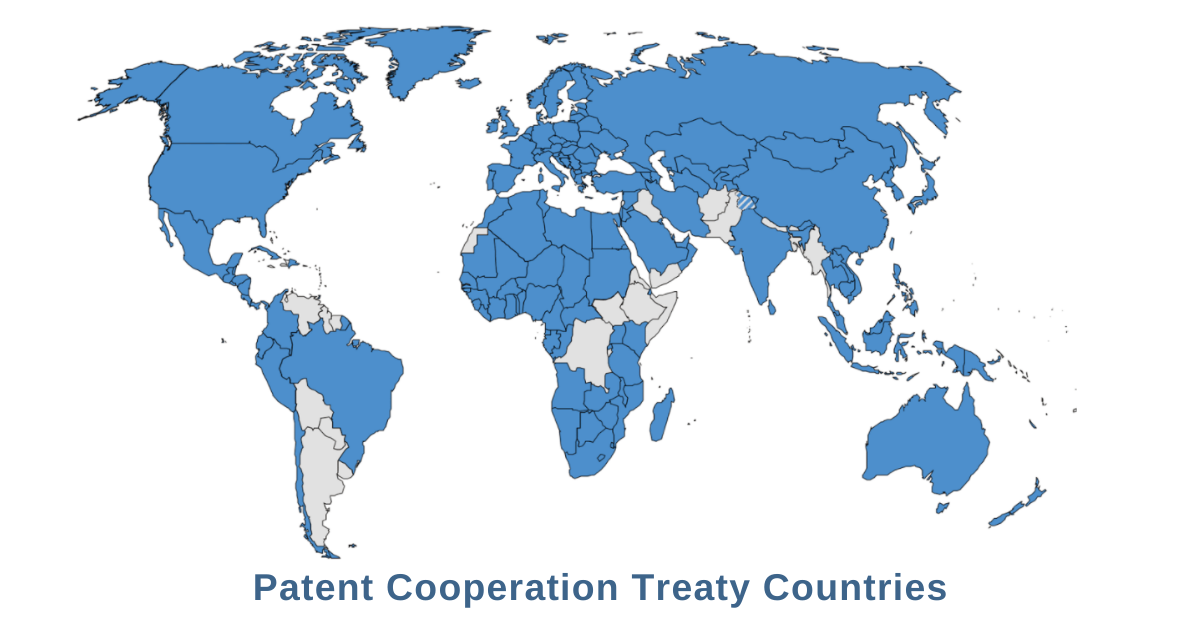A patent permits its owner to exclude others from making, using, selling, offering for sale, or importing the patented invention without his permission. A patent is, however, unique to the country where it is granted. Thus, if a patent owner does business in more than one country, it would be necessary to obtain a patent in each country to protect the invention.
Some countries have restrictions on what can be patented. For example, some countries do not permit patenting software, business methods, drugs, or methods of treatment for humans.
PCT Applications (Patent Cooperation Treaty)
One way to obtain patent protection in multiple countries is to file an application under the Patent Cooperation Treaty (PCT). A PCT application is an international application that is filed through the World Intellectual Property Office (WIPO), where applicants can designate a large number of countries in which they desire to file their patent application. Currently, 153 countries are members of the PCT.

A PCT application does not give the applicant an “international patent”, as all patents are national in nature (although certain organizations like the European Patent Office (EPO) issue a “European Patent” that must be registered in each member country where the applicant desires the patent to be in effect). Instead, the PCT provides a mechanism that gives the applicant 30 or 31 months from the earliest filing date (the first filed patent application) to determine whether to file the patent application in various individual countries. A PCT application can either be the first filed application for an invention or it must be filed within 12 months of the first filed application.
The PCT also provides an International Search Report (ISR) and an examination, if desired, so that the applicant can get an early search performed to see if the invention is patentable. The delay also permits the applicant to determine whether the invention is commercially valuable and whether it is worth spending the money to obtain a patent in each country. While applicants may designate all 153 countries at the time of the PCT filing, they can decide later in which individual countries they would like to pursue patent protection.
A PCT application can also save money on translation costs early in the process. While most individual countries require patent applications to be filed in the native language of that country, PCT applications permit applicants to delay the cost of translating the application into the various languages.
Entering the National Stage
Once the 30 or 31 month period from the first filing date elapses, a PCT applicant must “enter the national stage” in each country where a patent is desired. Otherwise, the application is abandoned and patent protection cannot be obtained. It is at this stage where translations must be obtained and filing costs for the various countries must be paid.
Each country usually requires that the applicant work through an attorney or patent agent who is registered to practice before that country’s patent office. Thus, to obtain a patent in Brazil, the applicant must work with a Brazilian patent attorney or agent. These attorneys and agents charge fees for their services, further adding to the costs of obtaining patent protection in various countries.
Direct Filing in Each Country
If the PCT procedure is not utilized, applicants must directly file in each individual country within a year of the filing date of the first filed application. The translation, filing, and agent costs are due at that time. A primary advantage of the PCT is the additional 18 to 19 month delay for these costs.
While 153 countries are currently members of the PCT, there are several significant countries that are not members; these include Argentina, Paraguay, Uruguay, Venezuela, Taiwan, and several countries in the Middle East. To obtain patents in these countries, a patent application must be filed in each within 12 months of the first filed application.
Many smaller countries will simply repeat the ISR or use one of the larger patent office search reports during prosecution of the patent application in those countries. The larger countries with more developed patent systems, however, will each conduct their own searches and examinations. These larger countries include the US, Europe, Japan, China, and a number of others. This can sometimes result in duplication of search and examination efforts in different countries and can even result in a patent being granted in some countries and denied in others.
Patent Prosecution Highway
The United States PTO has entered into an agreement with a number of other patent offices called the Patent Prosecution Highway. Under this program, once a patent claim is found to be allowable by the patent office where the application was first filed, the applicant may request that other patent offices fast track examination of the application. This is a type of work-sharing program intended to cut reduce redundancy in examination. Several other countries also offer PPH or other expedited examination programs once a patent for the invention has been obtained in another country, especially if it was obtained in one of the larger countries.
This blog is made available by Goodman Allen Donnelly for general information, and does not constitute legal advice. By reading this blog, you understand that there is no attorney-client relationship between you and the firm. This blog should not be used as a substitute for competent legal advice from a licensed professional attorney in your state.
